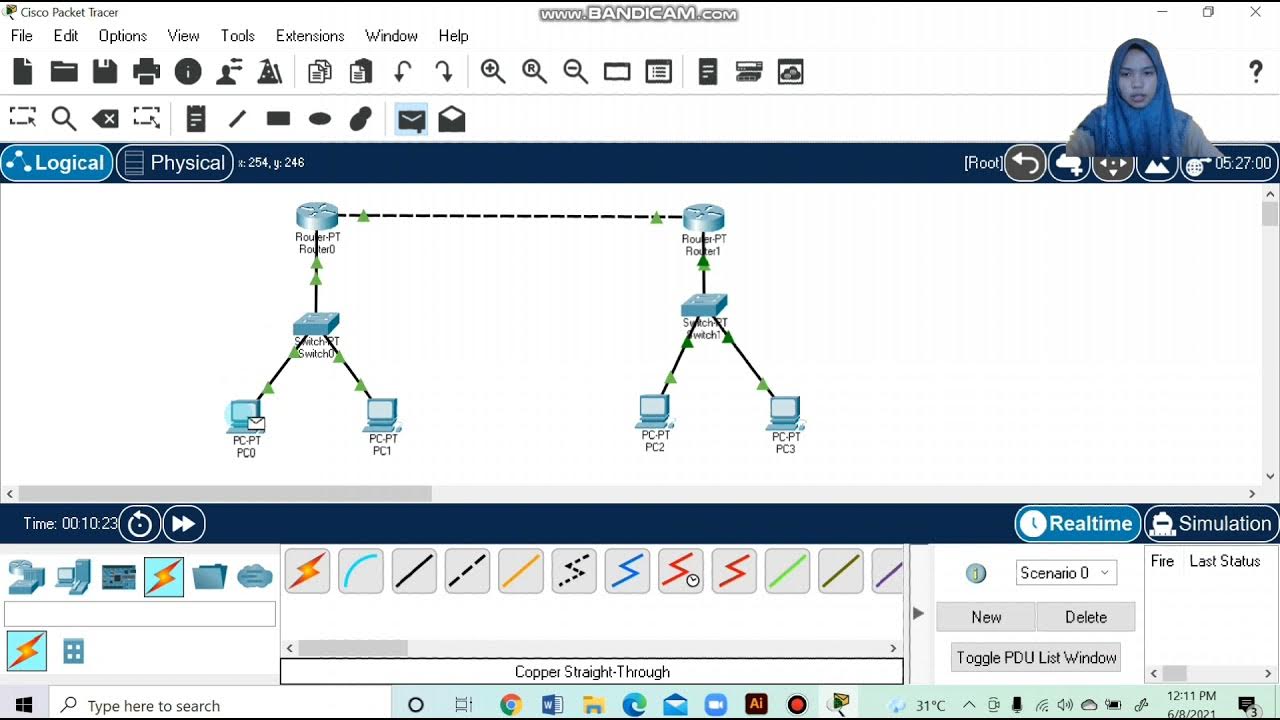Konfigurasi VLAN+STANDAR ACL pada CISCO Packet Tracer
Summary
TLDRIn this video, the presenter, Nyali Dwi Agustin Ning, discusses a network configuration task using Advan's Netbook, focusing on setting up IP addresses, DNS, routers, and switches within a specific topology. The demonstration includes configuring servers, PCs, and switches, with emphasis on ensuring proper routing and preventing unauthorized access between PCs and servers. Throughout, technical steps are presented with attention to interface settings and IP address assignments, culminating in a successful setup where restricted PCs cannot ping the server, fulfilling the assignment requirements.
Takeaways
- 😀 IP addresses for different network devices were carefully configured, including the web server, PCs, and routers, ensuring a stable network topology.
- 😀 DNS settings were adjusted to ensure proper name resolution across the network, allowing communication between different devices.
- 😀 A range of PCs with various IP addresses were set up, with particular attention to ensuring each one had the correct network configuration.
- 😀 Router configuration involved setting up RIP (Routing Information Protocol) to ensure routing between different segments of the network.
- 😀 The configuration of switches involved assigning VLANs to different segments, like the ones for 'Film 10' and 'Film 11', to manage network traffic more efficiently.
- 😀 A critical testing phase was included, where each PC successfully pinged the server, confirming that the network devices were communicating properly.
- 😀 The process involved configuring router interfaces with specific IP addresses to enable proper routing between the different devices and networks.
- 😀 Security measures were implemented by blocking specific PCs from accessing the server, ensuring control over which devices can communicate with critical network resources.
- 😀 The configuration also required using trunking on switches to support multiple VLANs and ensure proper communication between them.
- 😀 Finally, a test was performed to confirm that PCs from certain VLANs could not ping the server, verifying the implementation of access control and network security.
Q & A
What is the purpose of the configuration presented in the script?
-The purpose is to configure a network topology using various devices such as routers, switches, and PCs. The configuration includes setting IP addresses, DNS, routing protocols, and VLANs to ensure correct communication between devices.
How is the IP address assigned to the webserver in this configuration?
-The webserver is assigned the IP address 192.168.1.4 as per the script, and the DNS is also configured with an address within the same subnet (192.168.x.x).
What routing protocol is used in this configuration and why?
-The routing protocol used is RIP version 2. RIP is chosen for its simplicity in configuration and automatic routing updates across devices in the network.
How are switches configured to interact with the routers in this setup?
-Switches are configured with access ports for each device and a trunk port for communication with routers. The trunk port uses the 'switchport mode trunk' command to allow multiple VLANs to pass through.
What role does the 'ping' command play in this configuration test?
-The 'ping' command is used to test the connectivity between PCs and the server. It helps verify if the network configuration is correct and if devices can successfully communicate with each other.
What happens when a PC in Film 13 tries to access the server?
-PCs in Film 13 (IP addresses 10.10.10.72 and 10.10.10.73) are blocked from accessing the server by using Access Control Lists (ACLs) on the router to deny traffic from these IPs.
Why is it important to configure RIP on the routers in this scenario?
-Configuring RIP ensures that the routers share routing information dynamically, allowing them to know the best path to route packets across different subnets and maintain a functioning network.
What is the significance of the 'switchport mode access' command in the switch configuration?
-'switchport mode access' ensures that the switch port is dedicated to a single VLAN and does not carry traffic from multiple VLANs, which is essential for proper device segmentation and security.
What is the purpose of using 'config terminal' and 'exit' commands during the router configuration?
-'config terminal' allows the user to enter configuration mode on the router, where settings can be modified. The 'exit' command exits from configuration mode back to the main prompt, ensuring that changes are applied correctly.
How does the ACL configuration impact the functionality of the network?
-ACLs are used to control network traffic by permitting or denying access to specific IP addresses. In this case, ACLs prevent PCs in Film 13 from accessing the server, enforcing network security and proper access control.
Outlines

このセクションは有料ユーザー限定です。 アクセスするには、アップグレードをお願いします。
今すぐアップグレードMindmap

このセクションは有料ユーザー限定です。 アクセスするには、アップグレードをお願いします。
今すぐアップグレードKeywords

このセクションは有料ユーザー限定です。 アクセスするには、アップグレードをお願いします。
今すぐアップグレードHighlights

このセクションは有料ユーザー限定です。 アクセスするには、アップグレードをお願いします。
今すぐアップグレードTranscripts

このセクションは有料ユーザー限定です。 アクセスするには、アップグレードをお願いします。
今すぐアップグレード関連動画をさらに表示

Topologi Jaringan Menghubungkan 2 Router 2 Switch dan 4 PC Packet Tracer

UKK TKJ Paket 2 Tahun 2025 Full Versi Cepat

Cara Membuat Topologi Jaringan Sederhana Menggunakan IP Static di Cisco Packet Tracer

Merancang-Bangun Jaringan dengan Aplikasi Cisco Paket Tracert Version Mobile

DNS Server Configuration in Cisco Packet Tracer

DHCP - Penjelasan dan Implementasi - 7.4.1 Implement DHCPv4
5.0 / 5 (0 votes)
